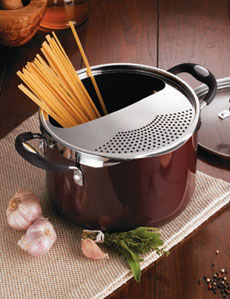TIP OF THE DAY: Top 10 Pasta Cooking Tips
|
It seems like a no-brainer to boil pasta, yet there are several “best practices.”
For National Pasta Month, here are some basic pasta tips that many people—including our interns—don’t know. 2. SALT THE WATER. Salt the water before you boil it—1-2 tablespoons for a large pot. You need the salt or the pasta will be bland. 3. NEVER ADD OIL TO THE POT. This longstanding “tip” was a marketing ploy from a salad oil company back around the 1960. The company sought ways for consumers to use more oil, and convinced many people that adding oil to the water prevents the pasta from sticking. However, the practice covers the pasta with a slick of oil so the sauce doesn’t stick. |
 This six-quart stock pot from Tramontina has a removable drain spout: No colander is needed to drain the pasta. |
|
|
4. PLACE A LID ON THE POT to EFFICIENTLY bring the water to boil. It takes long enough boil with a lid holding in the heat. You’ll be waiting forever (and water will evaporate) without one. 5. SCOOP UP A CUP OF PASTA WATER and set it aside before you drain the pasta. This starchy water can thicken your sauce. Add a tablespoon to the sauce, or more as desired. This is especially important with egg-based sauces like carbonara, since it also helps prevent the egg from curdling when it touches the hot pasta. 6. NEVER RINSE THE PASTA AFTER YOU DRAIN IT. This washes away the remaining surface starch, which you need in order for the sauce to stick to the pasta. |
||
 Another tip: Cut down on carbs by serving smaller portions of pasta as a first course, followed by a protein course. Photo courtesy Steak & Whisky. |
7. QUICKLY TOSS THE HOT PASTA WITH THE HOT SAUCE. While restaurants in the U.S. often place the sauce on top of the pasta, that’s a visual enhancement rather than a flavor enhancement. A top restaurant will serve the pasta already tossed with the sauce. The hotter both the pasta and the sauce are, the more flavor the pasta will absorb. Have the sauce heated in a covered pot (or in the microwave), ready to go when you drain the pasta.
8. USE THE POT TO BLEND THE PASTA AND SAUCE. After you’ve drained the pasta pot, dump the pasta back in, along with the sauce. Cover the pot and let the pasta absorb the sauce for a minute; then stir again and serve immediately. 9. ADD SOME MINCED FRESH HERBS. You can toss them with the pasta and sauce, or use it as a garnish on top of the dish. We also have a peppermill filled with crushed red chili flakes, to grind into the pasta or for self-service at the table. 10. USE REAL PARMESAN CHEESE. The best way to get the most robust cheese flavor is to keep a wedge and pass it around the table with a grater, so people can freshly grate as much as they like. |
|
|
HOW MUCH PASTA DO YOU NEED? Here’s advice from Barilla: |
||


